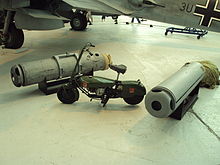CLE Canister

The CLE Canister, or CLE Container was a standardized cylindrical container used by the British during World War 2 to airdrop supplies to troops on the ground. The name initially derived from the Central Landing Establishment that developed them, although this was later backronymed to Container Light Equipment.[1]
Design

Initially, the canisters were of wood and metal construction. The Mark 1 canister weighted around 46 kilograms (101 lb) empty and 159 kilograms (351 lb) when filled. It was cylindrical, 1.7 metres (5.6 ft) long and 40 centimetres (16 in) in diameter. The Mark 1T canister was similar except it was of metal construction and slightly heavier, weighing 61 kilograms (134 lb) empty and again 159 kilograms (351 lb) when filled. The Mark III canister was similar, but slightly longer 1.8 metres (5.9 ft).[1]
One end of the canister carried a parachute pack. The parachute was deployed by a static line, which opened a pilot parachute, which in turn opened the main canopy. The other end of the canister was fitted with a pan-like structure that cushioned the impact of landing.[2] The canisters' attachment system allowed them to be carried from the bomb-racks of bomber aircraft.[3]
The canisters could be fitted with four battery-powered lights, to make them easier to find when dropped at night. There were also experiments with fitting them with smoke markers.[4]
Use and deployment

The canisters could contain food, ammunition, weapons or other equipment — the Mark 1 canister could carry 12 rifles and 1000 rounds of ammunition.[5] A cylindrical fuel can was also developed to fit the CLE Canister, with a canister able to accommodate three of the cans.[6] Some loads, such as radios, weren't dropped in CLE Canisters and required special containers to carry and protect them.[7]
Prepacked canisters were allocated code numbers according to their load; a unit requiring resupply simply had to communicate the code and the number of canisters required. The type of load was indicated by the colour of the parachute, so the contents could be identified without opening the container. The colours used were periodically changed to confuse the enemy.[3] During Operation Market Garden, for example, the colours used were red for ammunition, green for rations, white for medical supplies, blue for fuel and yellow for communication equipment.[8]
As well as World War II, the canisters saw use in Operation Musketeer - the 1956 Anglo-French invasion of the Suez Canal zone.[1]
See also
References
- ^ a b c Baker, Jon. "Container Light Equipment". ParaData.
- ^ Dennis Williams (15 July 2008). Stirlings in Action With the Airborne Forces: Air Support to Special Forces and the SAS During WW11. Pen and Sword. pp. 27–. ISBN 978-1-84415-648-1.
- ^ a b Rebecca Skinner (20 January 2015). British Paratrooper 1940–45. Bloomsbury Publishing. pp. 46–. ISBN 978-1-4728-0514-0.
- ^ "Military Pallets, Boxes and Containers – Part 7 Air Despatch". Think Defence. 2014-12-08. Retrieved 2020-05-09.
- ^ D. J. Sutton (1984). The Story of the Royal Army Service Corps and Royal Corps of Transport, 1945-1982. L. Cooper. p. 530. ISBN 978-0-436-50606-2.
- ^ "British Airborne Fuel Can". Summer Of 44. Retrieved December 25, 2012.
- ^ Steer (2000), p.97
- ^ Steer (2000), p.124-125
Bibliography
- Frank Steer (21 October 2000). Arnhem The Fight to Sustain: The Untold Story of the Airborne Logisticians. Pen and Sword. ISBN 978-0-85052-770-4.
